Perch Vs Walleye (How Are They Different?)
UPDATED 03 NOVEMBER 2023
By Robert Ceran
For novice anglers, walleye and perch can look superficially similar, since they share several key characteristics.
However, it’s important to be able to tell the difference between perch and walleye, since they have different size limits and bag limits in most states.
So you’ll need to know whether you just caught a perch or a walleye, in order to stay in compliance with your local fishing regulations.
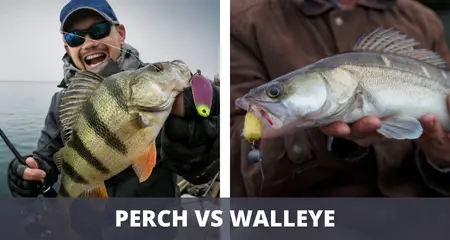
In this article we’ll show you through the key differences between perch vs walleye, to help you tell them apart easily on your next fishing trip, and will also discuss which one tastes better.
Are perch and walleye the same?
No – while perch and walleye are both part of the perch family of fish, they are separate fish species that belong to different genera and come with many key differences.
Now let’s take a closer look at each species and go over the most important perch and walleye facts:
Yellow perch
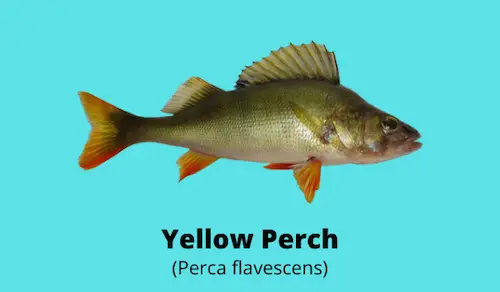
Scientific name: Perca flavescens
The yellow perch is also referred to as perch, striped perch, river perch, and American perch. It is very similar to its close cousin, the European perch (Perca fluvialis).
The perch is a small predatory fish that typically reaches sizes from 4 to 10 inches in length, and a maximum weight of 1 to 3 pounds. The world record yellow perch was 18 inches and 4 pounds 3 ounces, and was caught in New Jersey in 1865.
Perch feed on insect larvae, fish eggs, shrimp, crayfish, and small fish. Yellow perch are an important food source for both walleye and largemouth bass.
Walleye
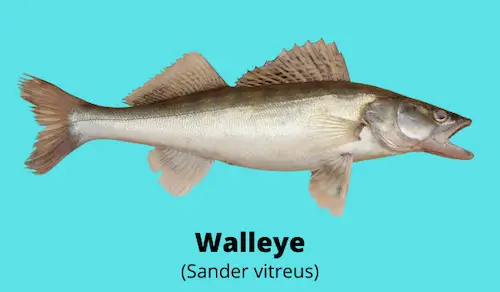
Scientific name: Sander vitreus
The walleye is also known as yellow pickerel or yellow pike, and is a close relative of the Sauger (Sander candensis) in North America, as well as the European zander (Sander lucioperca).
The walleye is a medium sized predatory fish that can grow up to 40 inches in length, and up to 25 pounds in weight. It is one of the most popular game fish in the US and Canada, and millions of anglers target walleye in North America every year.
The world record walleye was 41 inches long and weighed 25 pounds, and was caught in Tennessee in 1960 by Mabry Harper.
Adult walleye feed mostly on other fish, with yellow perch as one of their dominant prey species, in addition to ciscoes and minnows, as well as invertebrate animals such as worms, crayfish, and leeches.
Perch vs walleye identification
While perch and walleye share some broad similarities, they also have many key differences that make it straightforward to tell them apart.
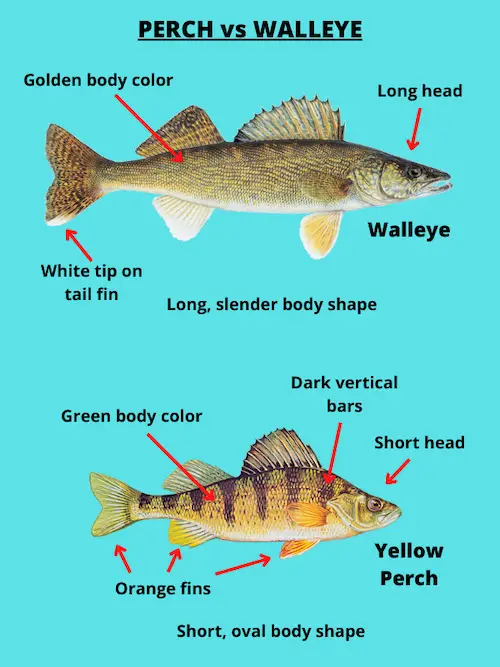
Size: Walleye are generally larger than perch. While most walleye caught by anglers are 8 inches long or longer, most yellow perch are less than 8 inches long.
However, in a few cases there is a size overlap between walleye and perch, in which case you can refer to the other differences listed below.
Shape: While walleye have an elongated and slender shape (which explains why they’re sometimes called pikeperch), yellow perch are more stocky and oval in shape. In addition, the head of a walleye is much longer and protrudes more than the head of a perch.
Color: While the overall coloration of walleye is olive or golden, yellow perch have an overall green or yellowish green body color. In addition to their green bodies, perch also have bright orange fins, which is a great characteristic you can use to distinguish perch from walleye.
In addition to these two color differences, walleye also have a very distinctive white spot on the bottom tip of their tail fin (which is actually a transparent area on the fin), and this spot is completely absent from yellow perch.
Vertical bars: While both walleye and perch have a series of dark vertical bars, those of the perch are much more distinctive and well defined, while the vertical bars of the walleye are more blurry, and tend to blend in with the background color.
Eyes: Walleye have a reflective layer of cells in their eyes that makes the eyes look cloudy or opaque. Perch, on the other hand, have regular fish eyes that are mostly dark, and look very different from those of walleye.
Overall, the easiest way to tell yellow perch and walleye apart is by their differences in color and shape. Once you have become familiar with these differences, you will never mistake these two species for each other again.
Where can you find yellow perch?
Yellow perch are common throughout the northern part of the USA, as well as southern areas of Canada. They live in water bodies of all sizes, ranging from small ponds to the Great Lakes and major river systems, such as the Mississippi river.
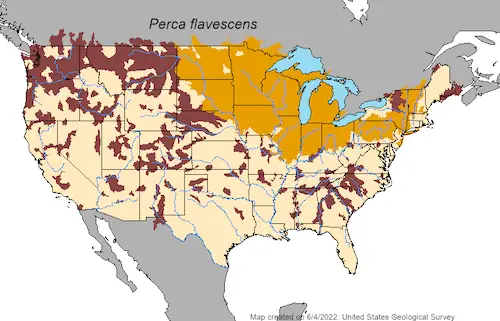
In addition to their native range, yellow perch have been introduced to many additional bodies of water, especially in the north western regions, but also in the south of the USA. In addition to being a popular game fish, perch are also highly regarded as a forage source for bass and walleye.
Where can you find walleye?
Walleye were originally restricted to the MidWest and the North East of the USA, as well as parts of Canada, but have been introduced to many additional locations over the decades.
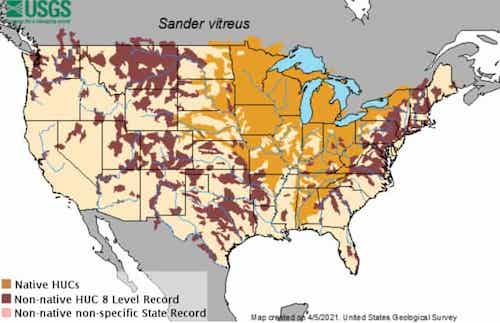
Walleye are now found as far south as Texas and New Mexico, where they have been introduced to reservoirs. However, their native range is definitely further north, and walleye populations in the south need to be maintained by continuous stocking efforts.
Are perch and walleye related?
Yes, perch and walleye both belong to the percidae family (also known as the perch family). However, while they share the same family, perch and walleye belong to different genera, so they are only distantly related to each other.
What is the perch family of fish?
The perch family (also known as Percidae) is a family of ray-finned fishes that belongs to the order Perciformes. It includes more than 200 species world wide, belonging to 11 different genera.
A key characteristic of the perch family is that its members have two dorsal fins (or rather a single dorsal fin that is split in two parts during development). The front dorsal fin has hard, pointed spines, while the rear dorsal fin has soft rays.
What are the members of the perch family in North America?
In North America, the perch family includes the following species:
- Yellow perch
- Walleye
- Sauger
- Saugeye
- Ruffe
- Darter
The ruffe was originally native to Europe and Asia, but was recently introduced into the Great Lakes of North America by mistake in 1986, where it has thrived since then. Ruffe can reach up to 10 inches in length.
Darters are not a single species, but actually consist of dozens of different species that are endemic to North America, and that rarely reach sizes over 4 inches in length.
Is there a walleye perch hybrid?
There is currently no evidence to support that walleye and perch can form hybrids with each other.
However, a study conducted at the university of Helsinki in Finland provided evidence of the first record of hybridization between the European zander (Sander lucioperca), and the European perch (Perca fluvialis).
Since these two species are very similar to their North American counterparts (walleye and yellow perch, respectively), it suggests that hybridization between yellow perch and walleye may be possible, though exceedingly rare.
Personally, I’ve never seen anything that looked like a walleye perch hybrid, and I’ve been catching both species for decades. And actually, the fact that walleye and perch don’t seem to hybridize makes a lot of sense, given they belong to different genera.
The genetic distance between walleye and perch is much larger than the distance between walleye and sauger, which belong to the same genus (Sander), and regularly hybridize to form saugeye.
Does Walleye Taste Like Perch?
Walleye tastes very similar to perch, although perch is slightly sweeter. In terms of texture and flakiness, walleye and perch are practically identical. If you batter and fry the filets, it’s very hard to tell the difference between walleye and perch.
And while both fish are good to eat, one key difference between them is that walleye are big enough to eat their cheeks (which are considered a delicacy), while perch are generally too small for that.
What Tastes Better – Perch or Walleye?
While walleye are more popular as food fish in North America than perch, many anglers actually prefer eating perch.
Also, keep in mind that walleye are higher in the food chain than perch, and in polluted waters this can cause an accumulation of heavy metals and toxins that can have a negative effect on taste.
At the end of the day, which species you prefer comes down to personal preference. For me personally, walleye cheeks are the best freshwater fish meal you can eat.
